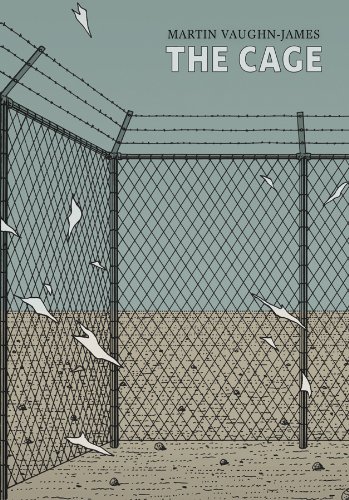 By MARTIN VAUGHN-JAMES (Coach House Books; 1975/2013)
By MARTIN VAUGHN-JAMES (Coach House Books; 1975/2013)
I’ve previously crowned Luigi Serafini’s CODEX SERAPHINIANUS the strangest book ever printed, but this newly reprinted relic from 1975 gives that tome a serious run for its money in sheer nonlinear weirdness. THE CAGE was also one of the first-ever graphic novels, having debuted before there was even a name for such things.
It followed ELEPHANT and THE PROJECTOR, two previous “visual novels” written and illustrated by the late Martin Vaughn-James (1943-2009), who provides a newly written (in 2006) introduction. I’d like to say the introduction sheds some light on THE CAGE’S inconclusiveness, but that’s not the case. What Mr. Vaughn-James does reveal is that he was inspired by the experimental fiction of Alain Robbe-Grillet and the French new wave film classic LAST YEAR AT MARIENBAD, and if you’re familiar with either you’ll have some idea of the sublime oddness contained herein.
The subject—it seems—is an ugly wire-rimmed cage whose true status appears to be largely symbolic. What’s being caged is never made clear, nor what function the cage might serve in this book’s procession of people-less landscapes, which include a Mayan temple, a featureless desert, somebody’s disheveled bedroom, a pumping station and a lavish palace interior, all rendered in richly detailed, almost photo-realistic black and white.
Yet these impeccably drafted landscapes are often defiled by M.C. Escher-like plays with perspective (the palace windows have a tendency to multiply exponentially) and some kind of complex recording machine that appears in various gravity-defying conjunctions, as well as a bed frame that spins and tilts. A tortured apocalyptic air predominates, along with an overall obsession with age and decay (crumbling bricks, sand and uncontrolled vegetation are constants). There’s also a formless black stain that frequently invades the frames, and monstrous shapes that appear to suggest some kind of extraterrestrial invasion.
Running alongside the pictures are blocks of text that, far from “explaining” things, only serve to deepen the mystery with their litany of cryptic (and oft-grammatically-incorrect) phrases (“a frozen geometry of mutilated props a silent drama a wingless crippled and carnivorous repertoire of shrieks…”) that appear to be commenting as much on the artwork itself as what it’s depicting.
What does all this “mean?” You’ve got me. There’s no narrative arc that I could find, nor any evident structure. Yet the whole thing is paradoxically quite rigorous and controlled in its execution, suggesting there is an overriding logic, even if that logic is subconscious in nature. Easiness and enjoyment are two things you won’t find here, but THE CAGE does make for a most fascinating and beautifully rendered puzzle whose nightmarish imagery lingers.
